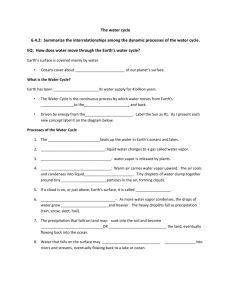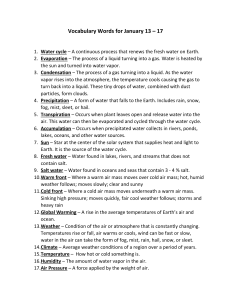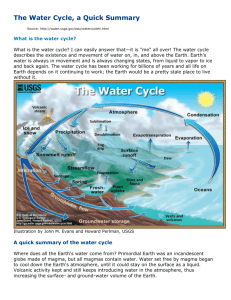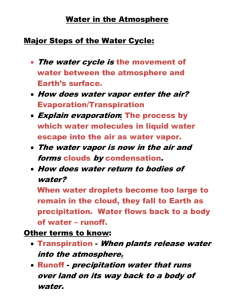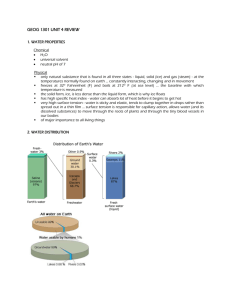Water Cycle Reference Reading
advertisement
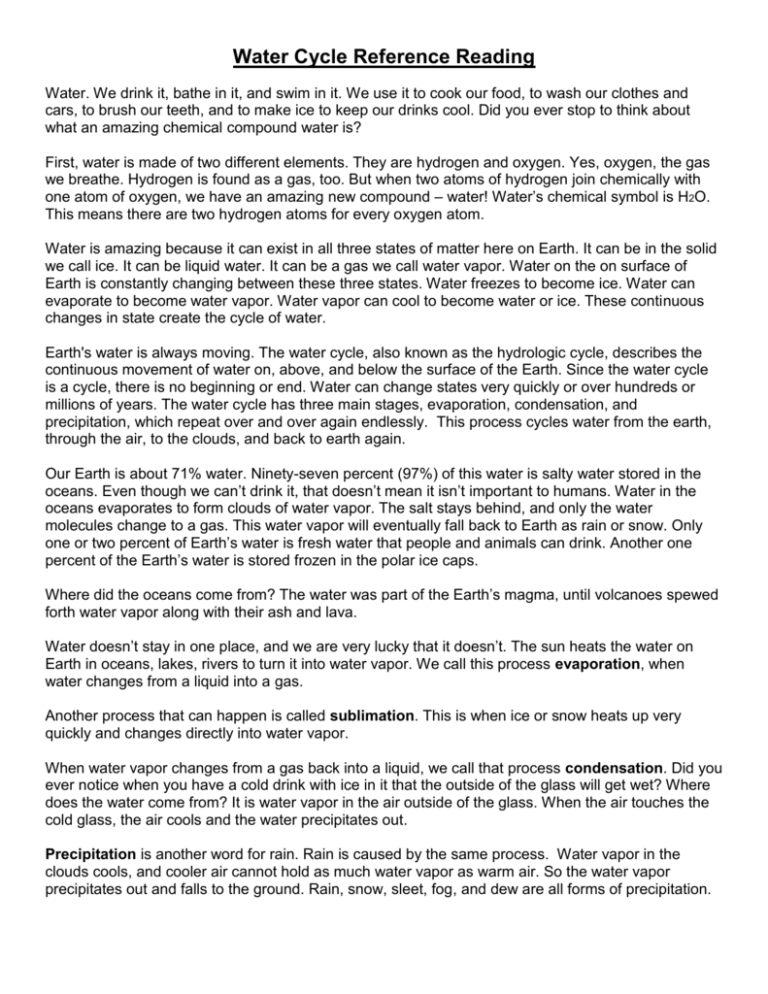
Water Cycle Reference Reading Water. We drink it, bathe in it, and swim in it. We use it to cook our food, to wash our clothes and cars, to brush our teeth, and to make ice to keep our drinks cool. Did you ever stop to think about what an amazing chemical compound water is? First, water is made of two different elements. They are hydrogen and oxygen. Yes, oxygen, the gas we breathe. Hydrogen is found as a gas, too. But when two atoms of hydrogen join chemically with one atom of oxygen, we have an amazing new compound – water! Water’s chemical symbol is H2O. This means there are two hydrogen atoms for every oxygen atom. Water is amazing because it can exist in all three states of matter here on Earth. It can be in the solid we call ice. It can be liquid water. It can be a gas we call water vapor. Water on the on surface of Earth is constantly changing between these three states. Water freezes to become ice. Water can evaporate to become water vapor. Water vapor can cool to become water or ice. These continuous changes in state create the cycle of water. Earth's water is always moving. The water cycle, also known as the hydrologic cycle, describes the continuous movement of water on, above, and below the surface of the Earth. Since the water cycle is a cycle, there is no beginning or end. Water can change states very quickly or over hundreds or millions of years. The water cycle has three main stages, evaporation, condensation, and precipitation, which repeat over and over again endlessly. This process cycles water from the earth, through the air, to the clouds, and back to earth again. Our Earth is about 71% water. Ninety-seven percent (97%) of this water is salty water stored in the oceans. Even though we can’t drink it, that doesn’t mean it isn’t important to humans. Water in the oceans evaporates to form clouds of water vapor. The salt stays behind, and only the water molecules change to a gas. This water vapor will eventually fall back to Earth as rain or snow. Only one or two percent of Earth’s water is fresh water that people and animals can drink. Another one percent of the Earth’s water is stored frozen in the polar ice caps. Where did the oceans come from? The water was part of the Earth’s magma, until volcanoes spewed forth water vapor along with their ash and lava. Water doesn’t stay in one place, and we are very lucky that it doesn’t. The sun heats the water on Earth in oceans, lakes, rivers to turn it into water vapor. We call this process evaporation, when water changes from a liquid into a gas. Another process that can happen is called sublimation. This is when ice or snow heats up very quickly and changes directly into water vapor. When water vapor changes from a gas back into a liquid, we call that process condensation. Did you ever notice when you have a cold drink with ice in it that the outside of the glass will get wet? Where does the water come from? It is water vapor in the air outside of the glass. When the air touches the cold glass, the air cools and the water precipitates out. Precipitation is another word for rain. Rain is caused by the same process. Water vapor in the clouds cools, and cooler air cannot hold as much water vapor as warm air. So the water vapor precipitates out and falls to the ground. Rain, snow, sleet, fog, and dew are all forms of precipitation. Since water moves in a circular motion, there is no one place that’s the beginning and one place that’s the end. Water moves through the cycle, sometimes in one direction, sometimes in another. Let’s look at the different parts of the water cycle. Let’s start with the oceans. Liquid water is stored there, and it cycles out as water vapor. Most of the earth’s water, about 97%, is stored in the oceans. The oceans provide about 90% of the water that goes into the water cycle. The sun heats the water enough so that some of it evaporates. Water vapor forms clouds. The clouds may cause some form of precipitation. It could be in the form of rain, sleet, or snow. Where does the other 10% come from? Much of it comes from lakes, rivers, and other areas of freshwater. Also, people, animals, and plants give off water vapor. In plants, the process is called transpiration. Plants take in water through their roots. They use this water to do the chemical process of photosynthesis, which is how plants make their own food. The process of photosynthesis gives off water, which is released through openings in the plants’ leaves (transpiration). It evaporates into the air as water vapor. People and animals breathe out water vapor from their lungs. This is called respiration. You can see the water if you blow onto a cold window. The “fog” on the glass is water vapor from your lungs. After water vapor gets into the air, it is carried into the upper atmosphere by rising air currents. As warm, moist air rises, it cools and condenses. The water vapor becomes water molecules or ice crystals and makes clouds. Air currents move clouds around the world. After enough water molecules gather in a cloud, they get heavy. Gravity will pull the water back toward Earth. The water will precipitate out and fall back to the Earth’s surface. After precipitation reaches land, it can do five different things. First, it could be absorbed by plants through their root system. It could soak into the ground and become groundwater. It could run off the land and go into a river, eventually flowing back into the ocean. It could fall in the form of snow and become part of a glacier or ice pack, where it might be stored for hundreds of years. Or it might just evaporate. Have you ever noticed a puddle after a rainstorm? The day it rains, there may be lots of puddles. In a few hours or a day or two, the puddles are gone. The water evaporated back into water vapor in the air. Groundwater is simply water that is stored in the ground. After rain falls on Earth and it soaks into the ground, it may stay there for a very long time. It becomes part of the water table. People make use of this stored water by digging wells. They must drill the well deep enough to penetrate the water table. When a well brings groundwater to the surface, it becomes part of the cycle again. Water is known as “the universal solvent.” A solvent is a substance that can dissolve a solid or gas. Water is called the universal solvent because it can dissolve many things. As water travels through the water cycle, it dissolves minerals in rocks and soil. Where do these minerals wind up? Where all water eventually winds up—in the oceans. The water can evaporate and leave the oceans, but the salts stay behind. That’s the reason oceans are salty!
